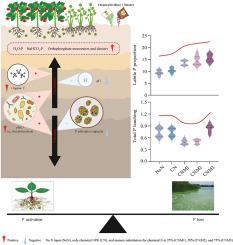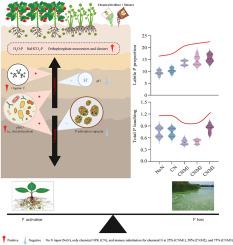长期有机替代下的磷有效性-淋滤权衡:协同微生物活化和吸附能力下降
IF 10
1区 环境科学与生态学
Q1 ENGINEERING, ENVIRONMENTAL
引用次数: 0
摘要
有机肥部分替代化肥可提高土壤磷素有效性;然而,在不同替代率下,磷供应和淋溶风险之间的权衡仍不清楚,特别是在微生物驱动的磷转化和土壤磷保持能力方面。在这里,我们结合了31P核磁共振、顺序提取和微生物学技术,在15年的现场实验中,用原位溶析仪研究了P的动力学。施用5种处理:不输入氮肥(NoN)、只输入化学氮磷钾(CN)和以25% (CNM1)、50% (CNM2)和75% (CNM3)的氮肥替代化学氮肥(NPK量相等)。与CN相比,有机肥替代显著提高了蔬菜产量和磷吸收量,番茄和芹菜15年平均产量分别提高了6.7% ~ 12.7%和10.5% ~ 15.4%。与非氮肥和氮肥相比,有机肥替代提高了番茄和芹菜季节土壤中稳定态和中度稳定态磷、正磷酸盐单酯和二酯含量、微生物量C和P含量以及碱性磷酸酶活性。CNM3增加了土壤磷素和缓生根瘤菌丰度,显著降低了磷吸附量,使总磷淋溶提高了20.5% ~ 23.7%,而CNM2提高了磷素微生物网络的复杂性和连通性,显著降低了磷淋溶6.3% ~ 30%。有机肥替代通过降低土壤pH值、促进有机碳积累和上调phoD基因来提高土壤中稳定磷含量。高有机肥替代主要通过降低磷吸附能力和刺激有机磷的微生物矿化来加剧磷的淋溶。这些发现为理解有机替代策略在土壤磷动态中的作用提供了新的见解,适度替代(≤50%)可以提高磷的有效性,同时减轻淋溶,为磷的可持续管理提供了关键策略。本文章由计算机程序翻译,如有差异,请以英文原文为准。


Phosphorus availability-leaching trade-offs under long-term organic substitution: Synergistic microbial activation and adsorption capacity decline
Partial substitution of chemical fertilizers with manure enhances soil phosphorus (P) availability; yet, the trade-off between P supply and leaching risks under varying substitution rates remains unclear, particularly with regard to microbial-driven P transformation and soil P retention capacity. Here, we combined 31P NMR, sequential extraction, and microbiology techniques in a 15-years field experiment with an in-situ lysimeter to investigate P dynamics. Five treatments were applied: no N input (NoN), only chemical NPK (CN), and manure substitution for chemical N at 25 % (CNM1), 50 % (CNM2), and 75 % (CNM3), with equal NPK amounts. Compared to CN, manure substitution significantly increased the vegetable yield and P uptake, 15-year average yields of tomato and celery increased by 6.7 %–12.7 % and 10.5 %–15.4 %. Compared with NoN and CN, manure substitution increased the contents of soil labile and moderately labile P, orthophosphate monoesters and diesters, microbial biomass C and P, and alkaline phosphatase activity in both the tomato and celery seasons. CNM3 increased soil phoD and Bradyrhizobium abundance, sharply decreased P adsorption capacity, and increased total P leaching by 20.5 %–23.7 %, while CNM2 resulted in higher complexity and connectivity of phoD-harboring microbial networks and significantly decreased P leaching by 6.3 %–30 %. Manure substitution enhanced labile P by decreasing soil pH, promoting organic C accumulation, and upregulating the phoD gene. High manure substitution exacerbated P leaching predominantly by reducing P adsorption capacity and stimulating microbial mineralization of organic P. These findings provide new insights into understanding the roles of organic substitute strategies in soil P dynamics, and moderate amount substitution (≤50 %) enhances P availability while mitigating leaching, providing a critical strategy for sustainable P management.
求助全文
通过发布文献求助,成功后即可免费获取论文全文。
去求助
来源期刊

Journal of Cleaner Production
环境科学-工程:环境
CiteScore
20.40
自引率
9.00%
发文量
4720
审稿时长
111 days
期刊介绍:
The Journal of Cleaner Production is an international, transdisciplinary journal that addresses and discusses theoretical and practical Cleaner Production, Environmental, and Sustainability issues. It aims to help societies become more sustainable by focusing on the concept of 'Cleaner Production', which aims at preventing waste production and increasing efficiencies in energy, water, resources, and human capital use. The journal serves as a platform for corporations, governments, education institutions, regions, and societies to engage in discussions and research related to Cleaner Production, environmental, and sustainability practices.
 求助内容:
求助内容: 应助结果提醒方式:
应助结果提醒方式:


